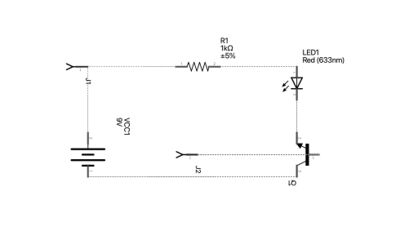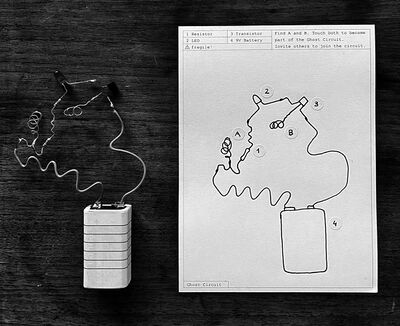User:Ohjian/Thesis-Outline: Difference between revisions
| Line 31: | Line 31: | ||
Writing about the context will help to explain the purpose and relevance of the tool. I hope to encourage readers to experiment with the modules and to reflect on the influence that tools have on their practice. | Writing about the context will help to explain the purpose and relevance of the tool. I hope to encourage readers to experiment with the modules and to reflect on the influence that tools have on their practice. | ||
<br><br><br><br> | |||
[[File:Touch schematics.jpg|400px|Standard Technical Schematics of a simple circuit]] | [[File:Touch schematics.jpg|400px|Standard Technical Schematics of a simple circuit]] | ||
[[File:Touch-circuit.jpg|400px|Annotated sketch of a simple circuit]] | [[File:Touch-circuit.jpg|400px|Annotated sketch of a simple circuit]] | ||
<br><br> | |||
Standard Technical Schematics of a simple circuit vs. Annotated sketch of a simple circuit | |||
<br><br><br><br> | |||
==<p style="color:#bbbbbb; text-shadow: 10px 10px 18px #FFB6C1, 10px 10px 18px #FFB6C1">Research question</p>== | ==<p style="color:#bbbbbb; text-shadow: 10px 10px 18px #FFB6C1, 10px 10px 18px #FFB6C1">Research question</p>== | ||
Revision as of 17:04, 7 December 2022
Thesis Outline
Mode of address and format
For my thesis I imagine a format that one could describe as a Situated and Annotated Manual.
Why a manual?
I want to use the well-known format of the manual to give detailed and technical information about the tool that I am creating in my graduation project. This includes hands-on descriptions on how the modules work and how to use them. This approach is quite formal, using standardized technical terms and schematics to give full insight and transparency.
Why annotations?
With the annotation layer I want to subvert this strictness of the technical manual and add a more intimate mode of address. I am hoping that informal notes, explanations and sketches make the manual more accessible to readers / users who are less familiar with technical terms and descriptions.
Why situated?
The tool I want to create is embedded in a whole context of discourse and practice. To help the reader / user to understand this environment I want to situate the manual and write about these references and relationalities.
Who do I address?
While the manual does justice to the technical complexity of the project, at the same time I want to make sure it is approachable for my specific audience: graphic designers and other makers who are unfamiliar with alternative tools and have little technical experience.
The annotations shall be a fun and playful way to take the technicalities serious yet make them more accessible and less overwhelming.
Writing about the context will help to explain the purpose and relevance of the tool. I hope to encourage readers to experiment with the modules and to reflect on the influence that tools have on their practice.


Standard Technical Schematics of a simple circuit vs. Annotated sketch of a simple circuit
Research question
How could the process of creating and introducing alternative tools help to reflect and re-shape practice?
Or more specific:
How can the concept of Modular Synthesis help to re-think Desktop Publishing
